Colored "Find what:" zone
-
Hi, all,
Very often, when making tests and building regular expressions, I’m very surprised and annoyed by the message
Find: Can't find the text '..........'… till I realize that current search mode is still set toNormal!So I thought about colouring the
Find what:zone, as shown in the picture :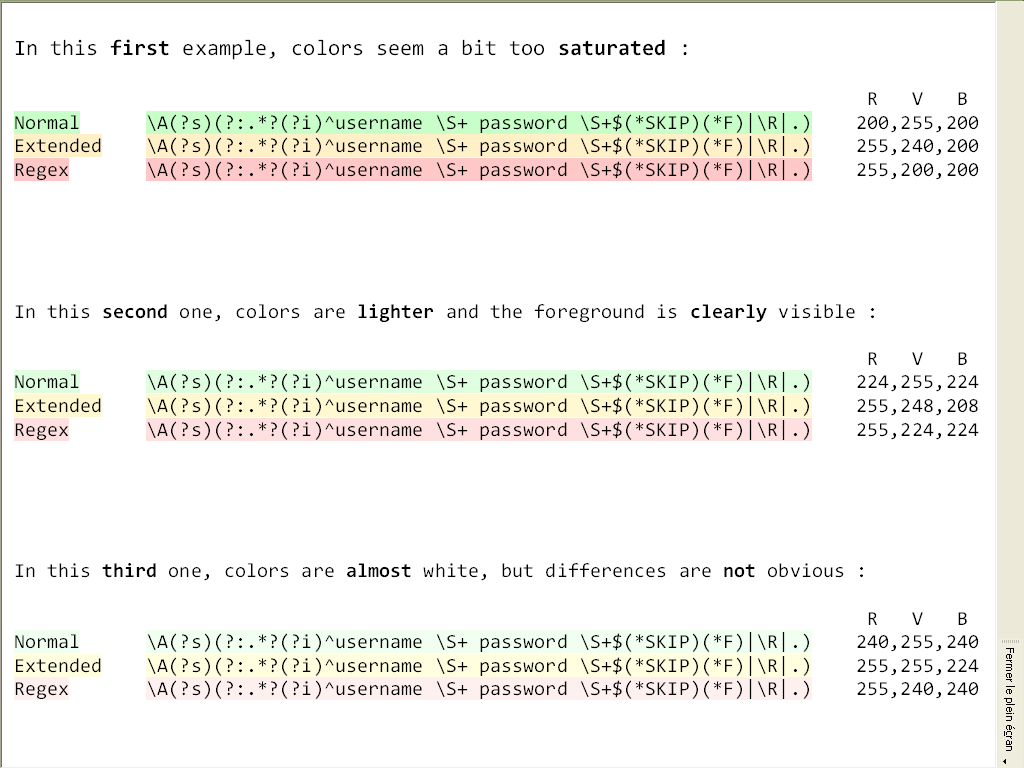
Before submitting this improvement, on GitHub, what is your feeling about this idea ? Personally, I quite like the second solution which seems a good compromise !
This indication would immediately inform us about the current search mode, for a possible change ;-))
Best Regards,
guy038
P.S. :
I also thought about a specific shortcut to open the
Finddialog with theRegular expressionautomatically ticked. But, in that case, what about theReplace,Find in FilesandMarkdialogs ? -
@guy038 ,
The only time I don’t have regex mode enabled is when I do a fresh unzip to help someone on the forum. And given that many of those are with old versions of Notepad++, a new feature wouldn’t help me. ;-)
That said, I would not mind some immediate indicator, like the colors you showed. Though I might suggest that Normal should be white (ie, the way it is now), Extended be one of the yellows you show, and Regex be the green; that way, it would tell us power users “green means you are in the right mode, yellow means you are in a weird mode, and boring white means default”.
-
Hello All,
The Peter’s advices are quite judicious ! Indeed :
-
Less colors are used than with my solution
-
For [ noob ] people, the
Normalmode would stay unchanged -
For people more involved with regexes, the color green is definitively more relaxing than any kind of red, anyway !
So, I updated my previous picture, as below :
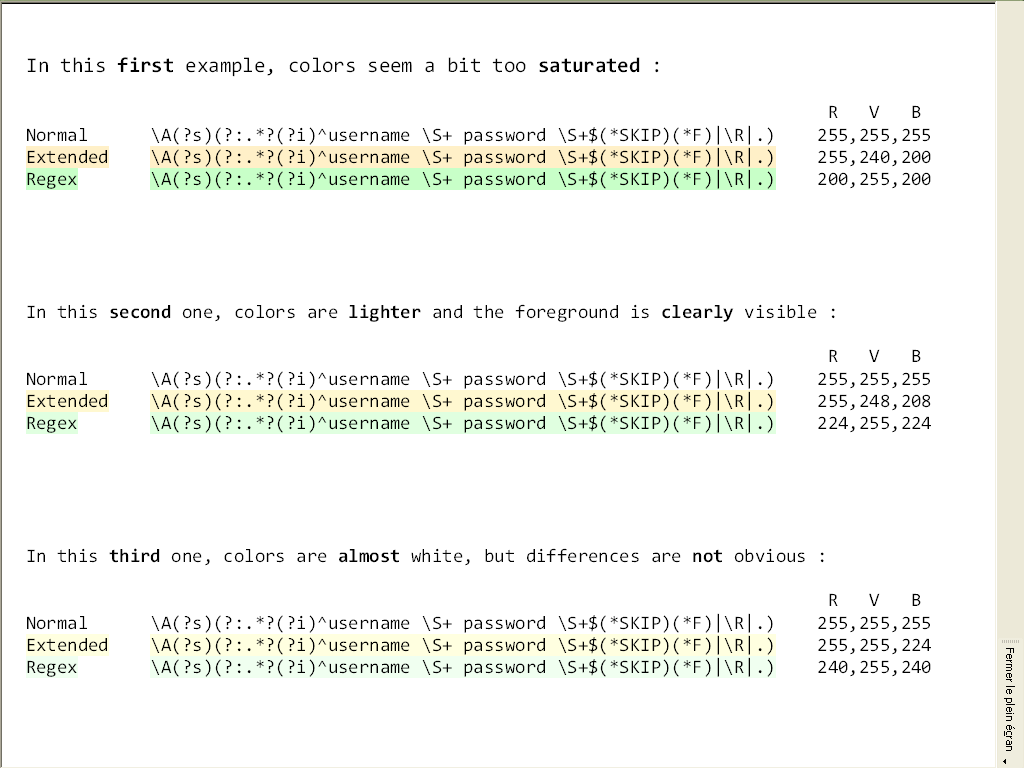
Best regards,
guy038
P.S :
Of course, @peterjones, like you and many others, I mainly use the
Regular expressionmode. However I also use theNormalmode when comparing two text zones which should be identical … in the end ! So I select the concerned zone, even on multiple lines, choose theNormalmode and tick theMatch caseoption.I, then, hit the
Ctrl + F3shortcut and any other selected area is, necessarily, strictly identical to the initial one. I use this method when I want to compare the expected result of anOPand the results obtained after running a specific S/R ! -
-
I don’t like color-coding these fields. One reason is that it is not obvious what the colors are for. I suppose experimentation by a user would reveal it.
I would much rather colors be used for an error condition (red) a non-error condition (green) or a warning condition (yellow). Not sure what these could mean in this context, but that’s what I think of for colors.
Why not just change the text to the left? Instead of “Find what”, how about “Find Regex” or “Find Ext” when in those modes. This moves the info closer to point-of-use.
I do agree that it can be a bit tedious when you accidentally search in the wrong mode, but I find that I accidentally search with “whole word” or “match case” on just as often as the wrong mode. So I think maybe the answer is pay closer attention to the UI, but that may not be a great answer.
Like Peter, I stay in regex mode most of the time. If I want normal, I just pop a quick
\Qon the front of my field (no need for a trailing\E). Although still in regex mode technically, it is effectively normal mode.And “Extended” mode – I say “bah! What good is that?”
I also use the Normal mode when comparing two text zones which should be identical …
Why not use the Search > Mark All feature for that?
If 2+ sections are identical, they instantly get the same colorization.
From this: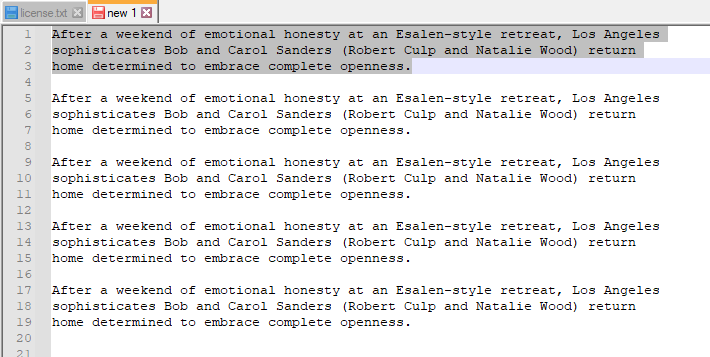
To this at the press of one keycombo:
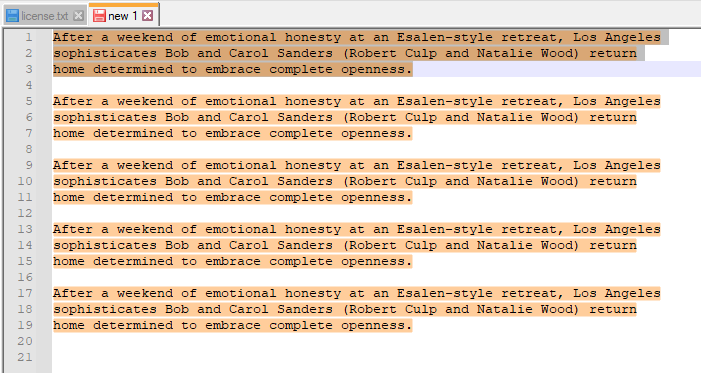
-
@guy038 said in Colored "Find what:" zone:
I also thought about a specific shortcut to open the Find dialog with the Regular expression automatically ticked. But, in that case, what about the Replace, Find in Files and Mark dialogs ?
How about opening the needed search dialog (e.g. Ctrl + F) and then pressing Alt + G to switch to the Regex mode?
-
Hello, @alan-kilborn, @mere-human and All,
So, you don’t fancy the color-coding feature ?!
You said :
Why not just change the text to the left? Instead of “Find what”, how about “Find Regex” or “Find Ext”
Well, one might say, with reason, just give a quick look to the search mode area, at bottom of dialogs !! I don’t think that would better noticed the change of the field :-(
You also said :
but I find that I accidentally search with “whole word” or “match case” on just as often as the wrong mode
You score one point, there !
And :
If I want normal, I just pop a quick \Q on the front of my field
I do use this form, sometimes, if I want to search, for instance, a text like
/* this a ( simple ) test of the \Q syntax ! */in regex mode ! However for multi-lines blocks of text, I prefer theCtrl + F3way. But, anyway, I need to know the current search mode !Finally, you added :
Why not use the Search > Mark All feature for that?
As I’ve just said, above, you must be sure that the current search mode is
Normalbefore running theMarkprocess !So a general solution seems not easy ! Many times, when building regexes, I’m obviously not
100%sure that it’s a right one. So, when I got aCan't findmessage I know that my try is syntactically correct but not exact and five minutes may pass before I realize that I am, stupidly, inNormalmode :-(Now, a solution could be to slightly change the look of the
FindandReplacebuttons, according to the current search modeA last idea, in the picture below :
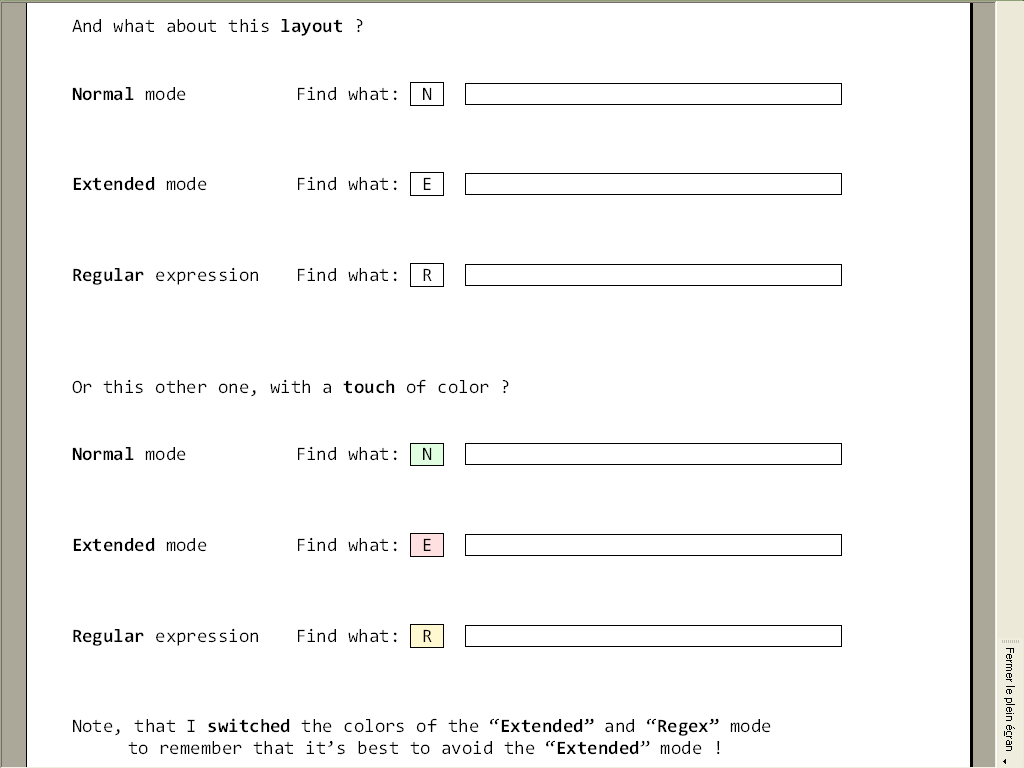
BR
guy038
Oh… yes, really interesting ! I’ve never used it before but I suppose, as a shortcuts-maniac person, that I will get used to, very easily ;-))
In addition, the
Gkey just follows theFkey, on any keyboard, all over the world ! -
@guy038 said in Colored "Find what:" zone:
I don’t think that this is your day for understanding my posts, or maybe I’m just not clear enough.
When I said:
Why not just change the text to the left? Instead of “Find what”, how about “Find Regex” or “Find Ext”
I didn’t mean change this as a user; just like your colors feature, having the text change would be done by the developers, when a mode is selected. Changing the text so that it is constant as a user can do is pointless here. Or maybe I misunderstand you as well.
But, having something much closer to the find box that shows the mode is better than at the bottom, no?
When I said:
Why not use the Search > Mark All feature for that?
I think you interpreted that as Search > Mark… instead, despite my orange (not red) coloring in my screenshot. The Mark All commands always work in “normal” mode on literal text; no regexes involved. (I think I remember something about a tie-in to Match case however?)
How about opening the needed search dialog (e.g. Ctrl + F) and then pressing Alt + G to switch to the Regex mode?
This is doable, but quite awkward. If it was Ctrl+f, Ctrl+g it would flow much better. But it’s not.
A last idea, in the picture below :
I’m not understanding that picture fully. Does it suggest to move search-mode into a one-letter dropdown, between the Find what text and the box itself? I don’t think that’s what you had in mind, but I kind of like that. :-)
If a user didn’t know what those N/E/R were they could hover and a speech callout could explain it.
But overall, sorry, no, I for one wouldn’t be on-board with the “colors” idea. But not everyone agrees with everyone else all the time (surely this site has reinforced that idea!).
It must be “the week” for people to come up with ideas to change the Find windows – right Terry? :-)
-
@mere-human said in Colored "Find what:" zone:
@guy038 said in Colored "Find what:" zone:
I also thought about a specific shortcut to open the Find dialog with the Regular expression automatically ticked. But, in that case, what about the Replace, Find in Files and Mark dialogs ?
How about opening the needed search dialog (e.g. Ctrl + F) and then pressing Alt + G to switch to the Regex mode?
Since sometimes the same thing happened to me as @guy038 tells, I solved the issue with a script. I couldn’t use
Alt + G, as you suggested, because I usually switch between two localizations, so I had to use another approach. Using RegEx, of course!The demo shows the English version of this AutoHotkey script, which can be easily adapted to other languages by adding or replacing the corresponding terms:
SetTitleMatchMode, RegEx ~^f:: ~^h:: ~^m:: WinWaitActive, Find|Replace|Mark ControlGet, status, Checked,, button18, Find|Replace|Mark If (status = 0) { SetControlDelay -1 ControlClick, button18, A ;checks regular expression } returnTake care and have fun!
-
Hello, @peterjones, @alan-kilborn, @mere-human, @astrosofista and All,
OMG, I must have been very tired last night and had my head elsewhere. Let’s start again :
- First, in my picture of my previous post, just pay attention to the small box, colored or not, between the mention
Find what:and the field where you type in your search regex. This box would not be a button at all , just a visual and/or colored mark, located near the zone to fill in, which would help us to remember the current search mode. ( Think of it as the colored boxes of the optionsSearch > Mark AllandSearch > Unmark All, with, in addition, the uppercaseN,EorRletter, inside )
-
I did understand that this small box would be updated, to the present search mode, by some new program code (not by user), when :
-
You open one of the
Finddialogs -
You manually click on a radio button of the
Search modesection
-
-
Now, regarding your Mark idea, I’m terribly sorry ! Indeed, I did not noticed that you spoke about the five
Mark Style #( withstyle 2in your picture ). Indeed, I do like this solution, too ! But you’re right : when using theSearch > Mark Alloption, the search is done with current state of theMatch Whole word onlyandMatch caseoptions. So, in order to detect strictly identical areas of text, I suppose that :-
The
Match Whole word onlyoption should be unset -
The
Match caseoption should be set
-
Now, in short, I finally think that it would not be valuable to submit such idea, regarding the @mere-human’s and @Astrosofista’s workarounds and the @alan-kilborn’s suggestion of the
Mark Stylefeature !And, anyway, I suppose that, for at least April, I will remember to check current search mode, just because I’ve had written all this stuff ;-))
Best Regards,
guy038
- First, in my picture of my previous post, just pay attention to the small box, colored or not, between the mention
-
@guy038 said in Colored "Find what:" zone:
just pay attention to the small box, colored or not, between the mention Find what: and the field where you type in your search regex. This box would not be a button at all
I think it actually has more value to truly BE a button, or, more accurately, a horizontally-narrow dropdown, where one could select, for example:
Nfor normal mode searchEfor extended mode searchRfor regular expression mode search (with . does not match newline)R.for regular expression mode search (with . matches newline)
Of course, when dropped, it could appear like this for maximum user help:
N : Normal Search ModeE : Extended Search ModeR : Regular Expression Search Mode (. does not match newline)R. : Regular Expression Search Mode (. matches newline)
With such a change, the
Search Modebox near the bottom of the window could be eliminated, making room for future searching goodie options! :-)Most users could just ignore it, and if it is small that is easy to do (just leave it set at
N). But for users that switch, something small and to the left of the text to find (Guy’s idea!) seems definitely worth it.I can’t believe I would get excited about a Find UI change that I know devs won’t like – because they don’t like any of these types of things.
I did not noticed that you spoke about the five Mark Style # ( with style 2 in your picture ). Indeed, I do like this solution, too !
I suppose I had forgotten that “styling” is controlled by match-case and match-whole-word settings. I think maybe that makes my suggested solution somewhat less great than I first thought. :-(
Somewhat like @astrosofista , I use automation to help keep these boxes clear when invoking a new Find, so I think that’s why I forgot.
-
Hi, @alan-kilborn and All,
Regarding the
Mark stylefeature, unfortunately, it cannot take in account a range of more of2,047characters too, as theFind what:zone :-(Just duplicate a zone of, let say,
5,000characters or so ! I had never done such a test before ;-))BR
guy038
-
@guy038 said in Colored "Find what:" zone:
Regarding the Mark style feature, unfortunately, it cannot take in account a range of more of 2,047 characters as the Find what: zone
Well, I had not encountered this before (having not attempted such a large “styling”) but it does not surprise me because clearly “styling” is going to involve Notepad++'s internal find routines to do its job. And those, as we know, have this 2047 limit.
But really, it isn’t much of a limitation to what we’re discussing (your usage when doing before/after regex replacement “compares”), right? Perhaps you were thinking that the “styling” method may be better because it might not have this limitation?
As an alternative for such a mechanism for such compares, what I do is to use an independent compare utility. The utility can do quick-to-invoke compares on the last two things copied to the clipboard. Thus it is perfect for your described application. Everyone touts the N++ Compare plugin, but I find a separate utility outside of N++, with possibly some hooks “into” N++ (via PythonScript) to be even more useful. Nothing against N++'s Compare plugin, however.
But, back to the 2047 (or is it 2046? I can’t remember) limit…
Is it truly 2047 characters, or is it 2047 bytes? Also a “can’t remember” for me. If it is “bytes” then, worst case for UTF-8 data, it might be as little as 2047-divided-by-4, or roughly 512 characters.
But even if it is characters, is such a limit “too small” for today’s conditions?
Maybe lobbying the N++ devs for an increase in this number is a reasonable thing to do? -
@Alan-Kilborn said in Colored "Find what:" zone:
I think it actually has more value to truly BE a button, or, more accurately, a horizontally-narrow dropdown,
One thing that my earlier proposal does NOT consider, is changing modes via keyboard.
I don’t currently have a great idea for this, without increasing the size on the UI.
But probably it is all pointless anyway, as Find UI changes are rarely considered by the devs. -
Hi, @alan-kilborn and All,
I did a series of tests and I’ve found out an interesting point about the
Find What:filling zone !!A) First case :-
Make a normal selection of some text or use the current selection
-
Hit the
Ctrl + F,Ctrl+ H,Ctrl + Shift + ForCtrl + Mshortcut. So, this selection usually fills in theFind What:zone, automatically
=> In this case, the maximum size of this zone is
2,046bytes, whatever the characters stored and the number of chars to encode each character. For instance, the stringAé▣🎷contains1 + 2 + 3 + 4bytes, in anUTF-8file. So,10bytes are inserted in theFind what:zoneB) Second case :-
Copy the current selection in the clipboard, with
Ctrl + C -
Cancel the current selection
-
Hit the
Ctrl + F,Ctrl+ H,Ctrl + Shift + ForCtrl + Mshortcut -
Delete the contents of the
Find What:zone, whatever it is -
Paste the contents of the clipboard with
Ctrl + V, in theFind whatzone
=> In that case, the maximum size of this zone is
2046chars and :-
Each character, with Unicode code-point
<= U+FFFF, stands for one character -
Each character, with Unicode code-point
> U+FFFF, stands for two characters !
So the same string
Aé▣🎷contains1 + 1 + 1 + 2chars. Thus,5pseudo characters are inserted in theFind what:zoneRemark that this case
B) occurs, also, for theReplace with:zone, as we need, necessarily, to fill in this zone with clipboard contents, anyway ! Therefore, the maximum size of theReplace with:zone is2,046characters, too, with the above distinction between characters within or outside theBMP!BTW, we get the same results whatever the current search mode used !
Best Regards,
guy038
P.S. :
For a quick test, note the differences between cases
A) andB) with the one-line text of the▣character (U+25A3), below :▣▣▣▣▣▣▣▣▣▣▣▣▣▣▣▣▣▣▣▣▣▣▣▣▣▣▣▣▣▣▣▣▣▣▣▣▣▣▣▣▣▣▣▣▣▣▣▣▣▣▣▣▣▣▣▣▣▣▣▣▣▣▣▣▣▣▣▣▣▣▣▣▣▣▣▣▣▣▣▣▣▣▣▣▣▣▣▣▣▣▣▣▣▣▣▣▣▣▣▣▣▣▣▣▣▣▣▣▣▣▣▣▣▣▣▣▣▣▣▣▣▣▣▣▣▣▣▣▣▣▣▣▣▣▣▣▣▣▣▣▣▣▣▣▣▣▣▣▣▣▣▣▣▣▣▣▣▣▣▣▣▣▣▣▣▣▣▣▣▣▣▣▣▣▣▣▣▣▣▣▣▣▣▣▣▣▣▣▣▣▣▣▣▣▣▣▣▣▣▣▣▣▣▣▣▣▣▣▣▣▣▣▣▣▣▣▣▣▣▣▣▣▣▣▣▣▣▣▣▣▣▣▣▣▣▣▣▣▣▣▣▣▣▣▣▣▣▣▣▣▣▣▣▣▣▣▣▣▣▣▣▣▣▣▣▣▣▣▣▣▣▣▣▣▣▣▣▣▣▣▣▣▣▣▣▣▣▣▣▣▣▣▣▣▣▣▣▣▣▣▣▣▣▣▣▣▣▣▣▣▣▣▣▣▣▣▣▣▣▣▣▣▣▣▣▣▣▣▣▣▣▣▣▣▣▣▣▣▣▣▣▣▣▣▣▣▣▣▣▣▣▣▣▣▣▣▣▣▣▣▣▣▣▣▣▣▣▣▣▣▣▣▣▣▣▣▣▣▣▣▣▣▣▣▣▣▣▣▣▣▣▣▣▣▣▣▣▣▣▣▣▣▣▣▣▣▣▣▣▣▣▣▣▣▣▣▣▣▣▣▣▣▣▣▣▣▣▣▣▣▣▣▣▣▣▣▣▣▣▣▣▣▣▣▣▣▣▣▣▣▣▣▣▣▣▣▣▣▣▣▣▣▣▣▣▣▣▣▣▣▣▣▣▣▣▣▣▣▣▣▣▣▣▣▣▣▣▣▣▣▣▣▣▣▣▣▣▣▣▣▣▣▣▣▣▣▣▣▣▣▣▣▣▣▣▣▣▣▣▣▣▣▣▣▣▣▣▣▣▣▣▣▣▣▣▣▣▣▣▣▣▣▣▣▣▣▣▣▣▣▣▣▣▣▣▣▣▣▣▣▣▣▣▣▣▣▣▣▣▣▣▣▣▣▣▣▣▣▣▣▣▣▣▣▣▣▣▣▣▣▣▣▣▣▣▣▣▣▣▣▣▣▣▣▣▣▣▣▣▣▣▣▣▣▣▣▣▣▣▣▣▣▣▣▣▣▣▣▣▣▣▣▣▣▣▣▣▣▣▣▣▣▣▣▣▣▣▣▣▣▣▣▣▣▣▣▣▣▣▣▣▣▣▣▣▣▣▣▣▣▣▣▣▣▣▣▣▣▣▣▣▣▣▣▣▣▣▣▣▣▣▣▣▣▣▣▣▣▣▣▣▣▣▣▣▣▣▣▣▣▣▣▣▣▣▣▣▣▣▣▣▣▣▣▣▣▣▣▣▣▣▣▣▣▣▣▣▣▣▣▣▣▣▣▣▣▣▣▣▣▣▣▣▣▣▣▣▣▣▣▣▣▣▣▣▣▣▣▣▣▣▣▣▣▣▣▣▣▣▣▣▣▣▣▣▣▣▣▣▣▣▣▣▣▣▣▣▣▣▣▣▣▣▣▣▣▣▣▣▣▣▣▣▣▣▣▣▣▣▣▣▣▣▣▣▣▣▣▣▣▣▣▣▣▣▣▣▣▣▣▣▣▣▣▣▣▣▣▣▣▣▣▣▣▣▣▣▣▣▣▣▣▣▣▣▣▣▣▣▣▣▣▣▣▣▣▣▣▣▣▣▣▣▣▣▣▣▣▣▣▣▣▣▣▣▣▣▣▣▣▣▣▣▣▣▣▣▣▣▣▣▣▣▣▣▣▣▣▣▣▣▣▣▣▣▣▣▣▣▣▣▣▣▣▣▣▣▣▣▣▣▣▣▣▣▣▣▣▣▣▣▣▣▣▣▣▣▣▣▣▣▣▣▣▣▣▣▣▣▣▣▣▣▣▣▣▣▣▣▣▣▣▣▣▣▣▣▣▣▣▣▣▣▣▣▣▣▣▣▣▣▣▣▣▣▣▣▣▣▣▣▣▣▣▣▣▣▣▣▣▣▣▣▣▣▣▣▣▣▣▣▣▣▣▣▣▣▣▣▣▣▣▣▣▣▣▣▣▣▣▣▣▣▣▣▣▣▣▣▣▣▣▣▣▣▣▣▣▣▣▣▣▣▣▣▣▣▣▣▣▣▣▣▣▣▣▣▣▣▣▣▣▣▣▣▣▣▣▣▣▣▣▣▣▣▣▣▣▣▣▣▣▣▣▣▣▣▣▣▣▣▣▣▣▣▣▣▣▣▣▣▣▣▣▣▣▣▣▣▣▣▣▣▣▣▣▣▣▣▣▣▣▣▣▣▣▣▣▣▣▣▣▣▣▣▣▣▣▣▣▣▣▣▣▣▣▣▣▣▣▣▣▣▣▣▣▣▣▣▣▣▣▣▣▣▣▣▣▣▣▣▣▣▣▣▣▣▣▣▣▣▣▣▣▣▣▣▣▣▣▣▣▣▣▣▣▣▣▣▣▣▣▣▣▣▣▣▣▣▣▣▣▣▣▣▣▣▣▣▣▣▣▣▣▣▣▣▣▣▣▣▣▣▣▣▣▣▣▣▣▣▣▣▣▣▣▣▣▣▣▣▣▣▣▣▣▣▣▣▣▣▣▣▣▣▣▣▣▣▣▣▣▣▣▣▣▣▣▣▣▣▣▣▣▣▣▣▣▣▣▣▣▣▣▣▣▣▣▣▣▣▣▣▣▣▣▣▣▣▣▣▣▣▣▣▣▣▣▣▣▣▣▣▣▣▣▣▣▣▣▣▣▣▣▣▣▣▣▣▣▣▣▣▣▣▣▣▣▣▣▣▣▣▣▣▣▣▣▣▣▣▣▣▣▣▣▣▣▣▣▣▣▣▣▣▣▣▣▣▣▣▣▣▣▣▣▣▣▣▣▣▣▣▣▣▣▣▣▣▣▣▣▣▣▣▣▣▣▣▣▣▣▣▣▣▣▣▣▣▣▣▣▣▣▣▣▣▣▣▣▣▣▣▣▣▣▣▣▣▣▣▣▣▣▣▣▣▣▣▣▣▣▣▣▣▣▣▣▣▣▣▣▣▣▣▣▣▣▣▣▣▣▣▣▣▣▣▣▣▣▣▣▣▣▣▣▣▣▣▣▣▣▣▣▣▣▣▣▣▣▣▣▣▣▣▣▣▣▣▣▣▣▣▣▣▣▣▣▣▣▣▣▣▣▣▣▣▣▣▣▣▣▣▣▣▣▣▣▣▣▣▣▣▣▣▣▣▣▣▣▣▣▣▣▣▣▣▣▣▣▣▣▣▣▣▣▣▣▣▣▣▣▣▣▣▣▣▣▣▣▣▣▣▣▣▣▣▣▣▣▣▣▣▣▣▣▣▣▣▣▣▣▣▣▣▣▣▣▣▣▣▣▣▣▣▣▣▣▣▣▣▣▣▣▣▣▣▣▣▣▣▣▣▣▣▣▣▣▣▣▣▣▣▣▣▣▣▣▣▣▣▣▣▣▣▣▣▣▣▣▣▣▣▣▣▣▣▣▣▣▣▣▣▣▣▣▣▣▣▣▣▣▣▣▣▣▣▣▣▣▣▣▣▣▣▣▣▣▣▣▣▣▣▣▣▣▣▣▣▣▣▣▣▣▣▣▣▣▣▣▣▣▣▣▣▣▣▣▣▣▣▣▣▣▣▣▣▣▣▣▣▣▣▣▣▣▣▣▣▣▣▣▣▣▣▣▣▣▣▣▣▣▣▣▣▣▣▣▣▣▣▣▣▣▣▣▣▣▣▣▣▣▣▣▣▣▣▣▣▣▣▣▣▣▣▣▣▣▣▣▣▣▣▣▣▣▣▣▣▣▣▣▣▣▣▣▣▣▣▣▣▣▣▣▣▣▣▣▣▣▣▣▣▣▣▣▣▣▣▣▣▣▣▣▣▣▣▣▣▣▣▣▣▣▣▣▣▣▣▣▣▣▣▣▣▣▣▣▣▣▣▣▣▣▣▣▣▣▣▣▣▣▣▣▣▣▣▣▣▣▣▣▣▣▣▣▣▣▣▣▣▣▣▣▣▣▣▣▣▣▣▣▣▣▣▣▣▣▣▣▣▣▣▣▣▣▣▣▣▣▣▣▣▣▣▣▣▣▣▣▣▣▣▣▣▣▣▣▣▣▣▣▣▣▣▣▣▣▣▣▣▣▣▣▣▣▣▣▣▣▣▣▣▣▣▣▣▣▣▣▣▣▣▣▣▣▣▣▣▣▣▣▣▣▣▣▣▣▣▣▣▣▣▣▣▣▣▣▣▣▣▣▣▣▣▣▣▣▣▣▣▣▣▣▣▣▣▣▣▣▣▣▣▣▣▣▣▣▣▣▣▣▣▣▣▣▣▣▣▣▣▣▣▣▣▣▣▣▣▣▣▣▣▣▣▣▣▣▣▣▣▣▣▣▣▣▣▣▣First case :
-
Select all the above text (
2,109chars ) -
Open the
Finddialog ( TheFins what:zone is filled in, automatically ) -
Tick the
Wrap aroundoption -
Click once only on the
Find Nextbutton
=>
682characters▣are selected ( each char is coded with three bytesE2 96 A3=>682 * 3 = 2,046bytes )Second case :
-
Select again all this text (
2,109chars ) -
Hit
Ctrl + C -
Cancel the selection
-
Open the
Finddialog -
Delete anything in the
Find what:zone -
Paste the clipboard contents with
Ctrl + V, in theFind what:zone -
Tick the
Wrap aroundoption -
Click on the
Find Nextbutton
=>
2,046characters▣are selected ( each char counts for itself, as its code-point is<= U+FFFF) -
-
@guy038 said in Colored "Find what:" zone:
I did a series of tests and I’ve found out an interesting point about the Find What: filling zone !!
This sounds like more than “interesting” behavior.
It sounds like “buggy” behavior.
And it sounds like possibly several bugs. :-( -
Hi, @alan-kilborn and All,
Yeah, I admit that it’s really border line ! Now, which case seems more logical and which case seems more interesting ?
I would say that :
-
The first case seems more logical as it considers the total amount of bytes inserted in the
Search what:zone, which is strictly equal to the total amount of bytes of the current selection, before calling theFinddialog -
Now, the second case, pasting contents in the
Search what:zone, is more interesting, of course, because we can search for a greater range of characters ( at least,2times more ) !
Best Regards,
guy038
-
-
I would say, that if the developers are going to set some kind of limit (and often in software a limit must be set), then for user convenience and understanding, it should be a character limit. Users don’t understand characters versus bytes (unless those numbers are strictly the same, and with UTF-8 and other encodings they are NOT).
And, different methods of entry should of course not alter the amount of data that can be accepted.
-
Hello, @alan-kilborn and All,
Yes, Alan, the
characterpoint of vue should be preferred to thebyteone, like, for instance, thesel :number, in status bar, which refers to characters ( not bytes ) !So, the second case should, therfore, be preferred. However, note that, presently, there is still a difference between chars in the
BMP, counting for one char and characters outside theBMP, counting for two. A bit weird, BTW ?BR
guy038
-
@guy038 said in Colored "Find what:" zone:
the character point of vue should be preferred to the byte one, like, for instance, the sel : number, in status bar, which refers to characters ( not bytes ) !
And the
Pos :number, in the status bar, bothers me somewhat, as it seems intuitively like it should be one character = one “position” change as you cursor over it. But for multibyte characters it is NOT a change of one.The Pythonscript programmer in me sort of understands this, however. Meaning how Scintilla deals with “position”.
chars in the BMP, counting for one char and characters outside the BMP, counting for two.
You might understand that way better than me.
The “two” makes me think of “surrogate pairs” but here is where I back off because I don’t know what I’m talking about. :-) -
Hello, @Alan-kilborn and All,
Thank, alan, for your feedback !
Yes, I know that the
Posnumber, in the status bar, refers to exact position (starting from0), in current file, of the first byte of the sequence needed to write a character, in a specific encoding ! For instance, theUTF-8sequence of the🎷character, representing a saxophone, is the four bytes sequence (F0 9F 8E B7). So, if you insert in a new tab, the stringA🎷Z0you can jump, with theSearch > Go to...feature, when theOffsetradio button is set, to :-
Pos 0, right before theAletter -
Pos 1, right before the🎷letter -
Pos 5, right before theZletter -
Pos 6, right before the0digit
And, if you try the offset
2,3or4, which are all within theUTF-8encoding of the🎷character, you would just jump to the nextZchar !This behavior is now correct, because I created an issue about this problem. Refer to this issue !
Now, I think that you’re right regarding your assumption about the two bytes used by a char, over the
BMP: this has really something to do with the two bytes of thesurrogatemechanism !For instance :
-
The regex to get the
🎷character, use its surrogate pair\x{D83C}\x{DFB7}( as we cannot use its complete hexadecimal code\x{1F3B7}) -
The general regex
(?-s).[\x{D800}-\x{DFFF}]finds any character over theBMP( Basic Multilingual Plane ), so with code-point over\x{FFFF}
BR
guy038
-